 |
|

|
 |
TABLE of CONTENTS
 |
Safety precautions save 10 MnDOT maintenance workers |
By Kristi Loobeek
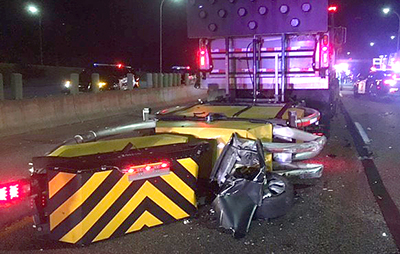
A truck-mounted attenuator on the back of a truck saved the lives of a MnDOT crew working on Hwy 77 in Bloomington May 25. Photo by Doug Theis |
When the unexpected came barreling towards a maintenance crew at 2:30 a.m., it was safety precautions more than luck that saved them.
In the wee hours of May 25, a crew of 10 MnDOT workers were outside of their trucks repairing guardrail on Hwy 77 in Bloomington. In the blink of an eye, a four-door sedan collided with the back of a MnDOT truck. The car rebounded off the first truck and ended up hitting the third truck in the line as well. Thankfully, no workers were injured. The driver and passenger of the car sustained only minor injuries. State Patrol later confirmed that the driver of the car was under the influence of alcohol at the time of the crash.
The device credited with minimizing the potentially disastrous effects of the crash is called a truck-mounted attenuator. The attenuator is an accordion-like structure designed to absorb the impact of a crash. Attenuators are placed at the back of work trucks for protection during rear-impact collisions. In this case, the attenuator did exactly what it was designed for and kept all workers safe.
Safety precautions are not all heavy equipment.
“At a minimum, crews wear high-visibility vests and a hat (hard or soft, depending on the situation),” said Keith Juliar, statewide safety coordinator. “For night operations, we add high-visibility pants as well. Additionally, the familiar orange cones with reflective stripes and flashing lights on trucks often accompany work zones—all tactics to be as visible as possible to passing motorists.”
Statewide maintenance work zone and technical specialist, Steve Blaufuss, added, “There is no 100 percent guarantee of protection on the roadways. The workers have been conditioned through training and experience that when they leave their truck stations, they must have a heightened sense of self preservation.”
Once on site, workers have a good understanding of the importance to get projects done quickly while never compromising safety.
“To balance safety with productivity is a challenge,” Blaufuss said. “One they face every day.”
The crash on May 25 occurred at night, not unusual timing for guardrail repair.
“Night work can be a good solution to a complex problem. Because of the nature of work performed, a traffic lane is often needed to be closed. That impacts traffic on a much smaller scale at night compared to during the day. The tradeoff is that night work can offer its own dangers, such as what we've witnessed from last week’s incident," Blaufuss said.
While safety precautions like the ones used this past week certainly saved lives, more can be done to protect highway workers, he said.
“The industry has done a good job of developing safety measures to protect workers like these,” said Blaufuss. “If it weren't for the use of crash attenuators, this would have been an incredible tragedy. MnDOT is currently in the process of researching the use of work zone intrusion devices that will add another layer of protection in the form of an early warning system to the workers. We are hopeful for the outcome of those research projects.”
|
 |
|

|
 |
TABLE of CONTENTS
 |
Legislature wraps up 2017 session after special session |
By Erik Rudeen, Government Affairs
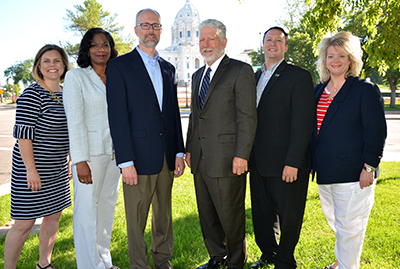
The Government Affairs team spent many hours at the Capitol meeting with legislators and attending hearings. From left are Molly Murphy, executive assistant; Terrina White, legislative mobility; Erik Rudeen, legislative liaison manager; Scott Peterson, Government Affairs director; Sean Rahn, assistant commissioner for policy; and Jennifer Witt, legislative policy analyst. Photo by Rich Kemp |
The 2017 legislative session ended at midnight May 22, and Gov. Mark Dayton immediately called legislators back to finish their work in a special session. Lawmakers finally passed the last budget bills in the early morning hours of May 26.
The omnibus transportation bill includes an additional $300 million from the general fund for the departments of Transportation, Public Safety and the Metropolitan Council, but there will be no increases in constitutionally dedicated funds for roads and bridges. Much of the new money will be used for local transportation projects, while about $50 million per year will go to the trunk highway fund.
The bill also authorizes $960 million in trunk highway bonds over four years, with $300 million for Corridors of Commerce and the rest for state road construction.
Several MnDOT policy initiatives are included in the bill:
- Establishing snow and ice contingency funds
- Providing for a highway sponsorship program
- Making trunk highway turn backs in Becker and Le Sueur counties
- Transferring McKinstry Mounds property in northern Minnesota to Historical Society
- Eliminating a sunset for targeted group business and veterans’ preference
- Making property conveyance changes
- Allowing milk trucks on interstates
- Providing federal conformity for pipeline welding trucks and commercial driver’s license learner permits
- Updating outdoor advertising provisions
- Modifying statewide plan due dates
Other enacted policy initiatives include additional weights for milk trucks, construction trucks, emergency vehicles and tire-hauling trucks. Modifications are made to MnDOT’s highway project selection process, and the department is required to implement efficiencies equal to at least 15 percent of appropriations above base-level spending. A new $75 annual surcharge is imposed on electric vehicles, an active transportation program is created and local bridge funding is segregated into projects below and above $7 million.
The Legislature also passed a bonding bill that provides nearly $1 billion for projects around the state. More than $250 million is provided to MnDOT for local roads and bridges, railroad enhancements and crossings, ports, airports and pedestrian improvements.
Check out the Legislature’s website for more information on the transportation and bonding bills. For additional information about the 2017 legislative session, see MnDOT’s Government Affairs website. The office will provide more detailed information about the session results for MnDOT in the next few weeks. |
 |
|

|
 |
TABLE of CONTENTS
 |
Groundbreaking ceremony for Red Wing Bridge project marks start of construction |
|
By Mike Dougherty, District 6 public affairs coordinator

Eric Davis, chief of staff, spoke at the groundbreaking ceremony May 26 for the Red Wing bridge. Davis talked about the partnership and good working relationship MnDOT shares with the city of Red Wing. Photo by David Gonzalez |
Federal, state and local officials gathered in Red Wing May 26 for a ceremonial groundbreaking to mark the start of construction on the Red Wing Bridge project.
Red Wing Mayor Sean Dowse served as emcee at the event that included remarks from local and state leaders during the short program.
“The Red Wing Bridge is a story about partnership between agencies, communities and states,” Dowse told the crowd. “It’s for the common good. The bridge that will be constructed will improve and enhance safety, our commerce and our efforts to welcome visitors to this community and region.”
MnDOT Chief of Staff Eric Davis echoed Dowse’s words, noting the partnership with Red Wing has been forged through other projects and been marked by good cooperation and projects that enhance the community.
WisDOT Northwest Region Director Jerry Mentzel lauded the hard work that many people have done to get the project to this point and complimented the working efforts of both WisDOT and MnDOT in taking on a complex project that will serve the Mississippi River corridor in this region.
The Hwy 63/Eisenhower Bridge will remain open to traffic during construction. The prime contractor on this $63.4 million project is Zenith Tech. The new bridge is expected to open to traffic by fall 2019.
This project includes building a new bridge to replace the Hwy 63/Eisenhower Bridge, replacing the historic Hwy 63 Bridge over Hwy 61, reconstructing approach roadways in Minnesota and Wisconsin, improving access to Red Wing and upgrading pedestrian and bicyclist crossings.
To learn more about the project or sign up for email updates, go to MnDOT’s project website www.mndot.gov/d6/projects/redwing-bridge/. You can also follow this project on Facebook at https://www.facebook.com/RedWingBridgeProject/.
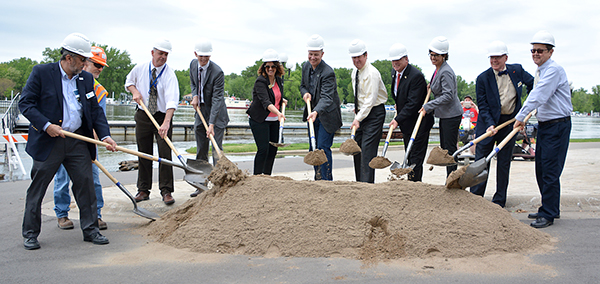
Federal, state and local officials participated in a ceremonial groundbreaking for the Red Wing Bridge project. From left, Jeff Vlaminck, District 6 engineer; Terry Ward, Red Wing Bridge construction project manager; Jerry Mentzel, WisDOT NW District director; Kyle Olson, aide to U.S. Sen. Amy Klobuchar; Bree Maki, aide to U.S. Sen. Al Franken; Eric Davis, MnDOT chief of staff; U.S. Rep. Jason Lewis; state Sen. Mike Goggin; state Rep. Barb Haley; Red Wing Mayor Sean Dowse; and Paul Drotos, Goodhue County commissioner. Photo by David Gonzalez |
|
 |
|
______________________________________________________________________________ -->

|
 |
TABLE of CONTENTS
 |
New pedestrian campaign targets driver, walker safety |
|
By Sue Roe

This is one of the messages MnDOT and DPS will use in a June public education campaign. The original artwork came from the North Carolina DOT and was adapted for MnDOT by Adam Oie, communications. |
The Office of Transit’s pedestrian and bicycle section is launching a new pedestrian safety campaign in June to raise awareness of the need for pedestrians and motorists to pay more attention when they’re walking and driving. The campaign will run from June 5 to July 2.
The $100,000 campaign includes billboards and radio, bus and social media advertising. The campaign will target the Twin Cities, Duluth, St. Cloud, Rochester, Mankato and Moorhead. The Department of Public Safety provided funding for the campaign.
“These areas all have higher rates of pedestrian/vehicle crashes,” said Melissa Barnes, state pedestrian and bicycle safety engineer. “In 2016, fatalities reached a 25-year high when 60 pedestrians were killed. That was 19 more than in 2015. And five months into 2017, there’s been 12 fatalities.”
Barnes and Michelle Pooler, program administrator, looked at what other states were doing with pedestrian safety and chose to use the campaign graphics from the North Carolina DOT.
“We liked the direction they take with pedestrian education and safety,” said Pooler. “We adapted our messaging to their graphics.”
Campaign messages include “Stop for people in crosswalks,” “Look again before you cross,” “Make eye contact with the driver” and “Stop for pedestrians at every corner.” Others, such as “Distractions are dangerous...pay attention when driving or walking” are directed to both motorists and pedestrians.
“We’re trying to tell the public that most of us are both motorists and pedestrians during a typical day,” said Barnes. “We want people to know that whether they are driving or walking, they should pay attention and put away their distractions.”
Once the campaign with DPS is over, MnDOT will continue to use the campaign materials, as they phase out the previous Share the Road program. The campaign will also expand to bicycle safety.
Share the Road was used for the past several years statewide to promote safe walking and bicycling. Barnes and Pooler are leading an effort with agency partners to develop an education and safety document that helps educate, encourage and improve the safety of people who walk and bike in the state.
“Out of this document will come the foundation for a new campaign,” said Pooler. “When funding becomes available, we’ll have the look of the campaign, the messaging, what the needs and priorities are and the long- and short-term goals for stakeholders to improve pedestrian and bicycle safety in the state.”
The first meeting of stakeholders will be in June and Pooler said the document should be completed next year. |
 |
|

|
 |
TABLE of CONTENTS
 |
Roy Forsberg, Kim Novak are eligible for vacation donation program |
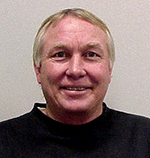
Roy Forsberg, District 2 maintenace, is eligible for the state vacation donation program. Photo courtesy of District 2 |
Roy Forsberg, District 2, and Kim Novak, District 3, are now eligible for the state vacation donation program.
Forsberg, has worked at MnDOT for more than 25 years, most of the time in the Bemidji Construction Office. He has a life threatening illness and is currently unable to work.
Novak has been a MnDOT employee since September 2008. She is a general maintenance worker in St. Cloud. Her husband Al was severely injured on a construction site. He sustained a spinal cord injury and multiple other fractures. Novak is involved in his therapy and will need to attend classes to ensure the family has the necessary information to manage the changes and risks that come with a spinal cord injury.
Forsberg and Novak have exhausted all of their sick and vacation leave. Donated vacation hours from state employees, who may donate up to 40 hours per fiscal year to one or more eligible employees, will help them stay on the payroll.
Also eligible for the vacation donation program are MnDOT employees Michael Peterson, transportation generalist in District 3; Emmett Trudeau transportation generalist in the Metro District; William Loher, geotechnical engineering section crew supervisor in the Office of Materials and Road Research; Rosemarie Merrigan, Office of Equity and Diversity; and Tina Warwick, employee development specialist in District 3. Check out the articles for Peterson, Trudeau, Loher, Merrigan and Warwick in previous Newsline articles.
To donate vacation hours, go to the Employee Self Service Web site and click “Other Payroll” and then “Leave Donations.” The site also allows employees to view a list of all state employees eligible for the program and to enroll as a recipient. |
 |
|

|
|

|
|

|
 |
TABLE of CONTENTS
 |
Whatís new on the Web |
Learning Center training dashboard
The Learning Center Dashboard recently got an upgrade, and is designed to give employees an at-a-glance overview of their training status and other activities in the Learning Management System. The dashboard is easy to read and highlights any upcoming or urgent actions that the employee is required to take. If you have been added to a class roster as an instructor, your profile will be recognized and additional features will be available when you sign on. Learn more and watch the online demo at the Learning Center ihub site: http://ihub/learningcenter/
Performance-Based Practical Design policy
MnDOT supports Performance-Based Practical Design, and directs its design professionals to consider applying PBPD principles where practicable on every project. The Federal Highway Administration has defined PBPD as a decision-making approach that uses quantitative analyses to guide decision-making through the project development process. PBPD helps better manage transportation investments and serve system-level needs and performance priorities with limited resources. Policy approved May 2017 |
 |
|

|
 |
TABLE of CONTENTS
 |
On the Job: Kristi Loobeek manages MnDOT's social media |
By Dana Hernandez
Do you or a co-worker have an interesting job to share with readers? Send us your ideas, and we’ll contact you for more information.
Recent employee profiles:
|
 |
|

|
 |
TABLE of CONTENTS
 |
WIG 2.0 Spotlight: Leadership team regroups, renews focus on achieving workforce equity goals |
By Eric Davis, chief of staff
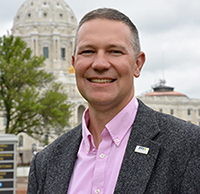
Eric Davis, chief of staff, is co-champion of the advancing equity priority area with Betsy Parker, chief counsel . Photo by Rich Kemp |
Under the Workforce Focus area of WIG 2.0, our charge is to advance equity through a more diverse, inclusive and culturally competent workforce. MnDOT has developed many reputable programs to effectively attract, retain and develop diverse talent. However, in too many job categories, gaps persist among women, racial and ethnic minorities, and people living with a disability, all of whom are available in today’s labor market, but underrepresented in our workforce.
Under the leadership of Mike Barnes, former assistant commissioner for Operations, the Workforce Area of WIG 2.0 established three key goals for recruitment, retention and training. He often reminded us of the importance of achieving a more representative, diverse and inclusive workforce. I’m most grateful to Mike for his many years of public service and for his committed leadership to advancing workforce equity.
New Workforce Focus Area Champion

Karin van Dyck
Photo by Judy Jacobs |
We’ve regrouped under new champions and a renewed commitment to achieving workforce equity. Human Resources Director Karin van Dyck has agreed to serve as our WIG 2.0 Workforce Focus Area champion. I’ve worked closely with Karin on a variety of Human Resources and workforce issues in my career and I can’t think of a better successor to step into this important role.

Bonnie Wohlberg
Photo by Rich Kemp |
New Recruitment Goal Champion
Bonnie Wohlberg, staffing manager, has agreed to champion efforts to attract highly qualified women, people of color and people living with disabilities who are currently underrepresented in our workforce by expanding recruitment sources and outreach to community partners.

Linda Hinrichs
Photo by Gene Olchefske |
New Retention Goal Champion
Linda Hinrichs, training manager, will shift from the training area to champion efforts at improving retention. Linda will guide agency efforts to more effectively hire, engage, develop and mentor employees throughout their careers, preparing leaders at all levels to take on progressively higher levels of responsibility.
New Training Goal Champion

Seema Desai
Photo by Rich Kemp |
Seema Desai, acting director of the Office of Equity and Diversity, will champion the training goal. MnDOT offers employees a variety of classes that help meet workforce goals, including the newly updated Respectful Workplace series, and the “Seeing the Difference: Building Cultural Competency” courses offered through OED.
We know transportation decisions can have very different economic, environmental and health impacts on different segments of our population. Our priority to advance equity under WIG 2.0 is also a commitment to the growing diversity of our customers and will help us to better understand and better balance the diverse needs of all to achieve the best possible outcomes.
“A government that serves the people of Minnesota should reflect the rich diversity of Minnesota. We must ensure that all Minnesotans have equitable opportunities to work for their state government, to do business with the state, and to participate fully in the development of policy within our democracy.”
Gov. Mark Dayton |
 |
|
| |
|



